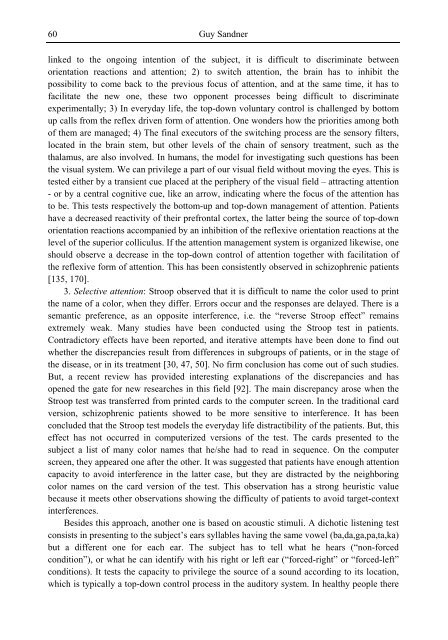Schizophrenia Research Trends
Schizophrenia Research Trends
Schizophrenia Research Trends
- No tags were found...
Create successful ePaper yourself
Turn your PDF publications into a flip-book with our unique Google optimized e-Paper software.
60Guy Sandnerlinked to the ongoing intention of the subject, it is difficult to discriminate betweenorientation reactions and attention; 2) to switch attention, the brain has to inhibit thepossibility to come back to the previous focus of attention, and at the same time, it has tofacilitate the new one, these two opponent processes being difficult to discriminateexperimentally; 3) In everyday life, the top-down voluntary control is challenged by bottomup calls from the reflex driven form of attention. One wonders how the priorities among bothof them are managed; 4) The final executors of the switching process are the sensory filters,located in the brain stem, but other levels of the chain of sensory treatment, such as thethalamus, are also involved. In humans, the model for investigating such questions has beenthe visual system. We can privilege a part of our visual field without moving the eyes. This istested either by a transient cue placed at the periphery of the visual field – attracting attention- or by a central cognitive cue, like an arrow, indicating where the focus of the attention hasto be. This tests respectively the bottom-up and top-down management of attention. Patientshave a decreased reactivity of their prefrontal cortex, the latter being the source of top-downorientation reactions accompanied by an inhibition of the reflexive orientation reactions at thelevel of the superior colliculus. If the attention management system is organized likewise, oneshould observe a decrease in the top-down control of attention together with facilitation ofthe reflexive form of attention. This has been consistently observed in schizophrenic patients[135, 170].3. Selective attention: Stroop observed that it is difficult to name the color used to printthe name of a color, when they differ. Errors occur and the responses are delayed. There is asemantic preference, as an opposite interference, i.e. the “reverse Stroop effect” remainsextremely weak. Many studies have been conducted using the Stroop test in patients.Contradictory effects have been reported, and iterative attempts have been done to find outwhether the discrepancies result from differences in subgroups of patients, or in the stage ofthe disease, or in its treatment [30, 47, 50]. No firm conclusion has come out of such studies.But, a recent review has provided interesting explanations of the discrepancies and hasopened the gate for new researches in this field [92]. The main discrepancy arose when theStroop test was transferred from printed cards to the computer screen. In the traditional cardversion, schizophrenic patients showed to be more sensitive to interference. It has beenconcluded that the Stroop test models the everyday life distractibility of the patients. But, thiseffect has not occurred in computerized versions of the test. The cards presented to thesubject a list of many color names that he/she had to read in sequence. On the computerscreen, they appeared one after the other. It was suggested that patients have enough attentioncapacity to avoid interference in the latter case, but they are distracted by the neighboringcolor names on the card version of the test. This observation has a strong heuristic valuebecause it meets other observations showing the difficulty of patients to avoid target-contextinterferences.Besides this approach, another one is based on acoustic stimuli. A dichotic listening testconsists in presenting to the subject’s ears syllables having the same vowel (ba,da,ga,pa,ta,ka)but a different one for each ear. The subject has to tell what he hears (“non-forcedcondition”), or what he can identify with his right or left ear (“forced-right” or “forced-left”conditions). It tests the capacity to privilege the source of a sound according to its location,which is typically a top-down control process in the auditory system. In healthy people there
















